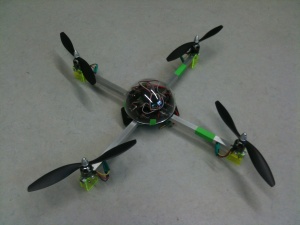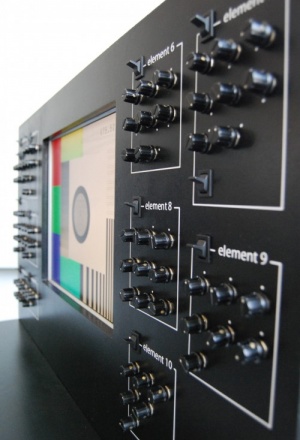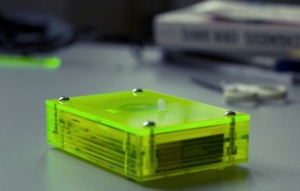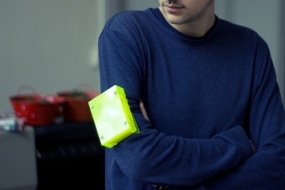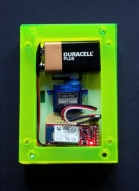User:Jasper van Loenen/grad/draft proposal v2: Difference between revisions
No edit summary |
No edit summary |
||
| (3 intermediate revisions by the same user not shown) | |||
| Line 3: | Line 3: | ||
== Tentative Title == | == Tentative Title == | ||
< Insert Very Tentative Title Here > | < Insert <b>Very</b> Tentative Title Here > | ||
== General Introduction == | == General Introduction == | ||
<div style="float:right;margin-left:10px;margin-bottom:10px;">[[Image:quad_v1_5.jpg|300px]]<br /><br />{{youtube|nxbcIfFTq4s}}</div> | |||
Looking for inspiration for the graduation project I focused on the practical projects I've done - the work related to my love for physical installations and electronics. I looked into some different | <p>Looking for inspiration for the graduation project I focused on the practical projects I've done - the work related to my love for physical installations and electronics. I first looked into some different topics like teleconferencing and AI, but even though I find these fields interesting they topics are not things I've worked with before and it felt quite forced. During this time I was working on a small side-project for myself and I decided to use this in my graduation project.</p> | ||
<p>What I was doing, was building a quadcopter - a small radio-controlled UAV (unmanned aerial vehicle) with 4 propellors. At first I didn't want to use this for my graduation project because it started as something that was just for fun but after giving it some more thought, I noticed that it touches on several of the topics I was interested in when I signed up for the Networked Media course. First of all, it is something I built myself using techniques from the maker scene - in this case laser cutting and 3D printing - and all the software used is open source and is being developed by a community, in which I've become involved as well.</p> | |||
<p>Apart from being an interesting object from a technical point of view, the availability of these things raises all kinds of questions, like about privacy and legality. Another interesting aspect is that people, as intrigued as they can be by flying things, are often just as scared of them - I've already noticed this during the few times I've flown the quad around - and some even compare these small UAVs to the bigger military drones.</p> | |||
<p>Because of this fear, I think it will be interesting to try to come up with ways to use them in a positive way - and not just a flying toy. It can be a platform for a whole range of activities but to narrow it down a bit - to prevent the project to be too broad and all over the place - it will be good to focus on a single topic at this point. One of the first ideas of things to do with a quadcopter was to use it to distribute seeds - possible using gps to guide it and make a pattern, drawing or text - so the direction of the project will be to use the quadcopter as a tool for urban / guerilla gardening.</p> | |||
<p>With guerrilla gardening people use neglected pieces of land in cities to grow flowers, vegetables or other plants, either to reclaim the land or to brighten up a neighborhood. A remotely controlled uav could help to get to normally hard to reach places or coordinate the work from above. It will be interesting to see how you can use these flying devices as tools to aid this (and possible other) communities.</p> | |||
== Relation to previous practice == | |||
<div style="float:right;margin-left:10px;margin-bottom:10px;">[[Image:testscreen.jpg|300px]]</div> | |||
<p>My previous work often dealt with the manifestation of digital systems; ''Test Screen'' was an interface to connect to an abstract piece of code. The installation consists out of groups of dials and switches (96 in total) around a flatscreen monitor, set in a large (110x60cm) wooden panel. I wrote a small computer program that would display an image similar to the old television test screens and each of the dials and switches was connected to a part of the script of this program. By manipulating the controls, the audience was able to change my code and change what would be displayed. I choose to not use a generic computer with keyboard and mouse but to built a custom interface as a way to get the audience more involved, since for many using such an unknown interface is far more appealing - and telling by the time some visitors spent at the installation it worked.
The form of the object (it's size and layout of switches and dials) was based on the code you were able to change with it and wouldn't really fit any other program - it reflected the character of the system.</p> | |||
<p>The same can be said for ''The Poking Machine'' (''TPM''), which I made together with [http://pzwart3.wdka.hro.nl/wiki/User:Grrrreat Bartholomäus Traubeck]. Facebook Users can poke each other by clicking a button on their profile pages and the recipient will receive a message saying he or she was poked. ''TPM'' is a small (9 x 7 x 5 cm) box made out of green transparent Perspex which you can strap to your upper arm using the attached piece of velcro. It will then use your phoneʼs internet connection to keep track of incoming pokes and when it detects one, a small plastic lever will come out of the box to physically poke you in the arm. This translates this meaningless written message into an actual poking gesture.</p> | |||
[[Image:Poking-Machine.jpg|300px]] | [[Image:Poking-Machine.jpg|300px]] | ||
| Line 28: | Line 29: | ||
[[Image:Poking-Machine-Inside.jpg|139px]] | [[Image:Poking-Machine-Inside.jpg|139px]] | ||
<p>Both of these projects were largely born out of an interest for technology and building things from scratch.</p> | |||
== References == | == References == | ||
* P.W. Singer, (2010) Wired for War<br /> | * P.W. Singer, (2010) Wired for War<br /> | ||
* N. Katherine Hayles, (2005) My mother was a computer<br /> | * N. Katherine Hayles, (2005) My mother was a computer<br /> | ||
* N. Katherine Hayles, (1999) How we became post human, virtual bodies in cybernetics, literature, and informatics<br /> | * N. Katherine Hayles, (1999) How we became post human, virtual bodies in cybernetics, literature, and informatics<br /> | ||
* R Barbrook (2005) Imaginary Futures, | * R Barbrook (2005) Imaginary Futures, | ||
* Where is my robot? (2008), Danny Wallace | * Where is my robot? (2008), Danny Wallace | ||
* Isaac Asimov | * Isaac Asimov | ||
</div> | |||
<div style="color:white;"> | |||
Hoffmann, E.T.A., (1816) The Sandman<br /> | |||
The Hunt for AI (2012), Marcus Du Sautoy<br /> | |||
Hugo (2011), Martin Scorsese (based on the children's book by Brian Selznick)<br /> | |||
</div> | </div> | ||
Latest revision as of 17:40, 3 December 2012
Tentative Title
< Insert Very Tentative Title Here >
General Introduction
Looking for inspiration for the graduation project I focused on the practical projects I've done - the work related to my love for physical installations and electronics. I first looked into some different topics like teleconferencing and AI, but even though I find these fields interesting they topics are not things I've worked with before and it felt quite forced. During this time I was working on a small side-project for myself and I decided to use this in my graduation project.
What I was doing, was building a quadcopter - a small radio-controlled UAV (unmanned aerial vehicle) with 4 propellors. At first I didn't want to use this for my graduation project because it started as something that was just for fun but after giving it some more thought, I noticed that it touches on several of the topics I was interested in when I signed up for the Networked Media course. First of all, it is something I built myself using techniques from the maker scene - in this case laser cutting and 3D printing - and all the software used is open source and is being developed by a community, in which I've become involved as well.
Apart from being an interesting object from a technical point of view, the availability of these things raises all kinds of questions, like about privacy and legality. Another interesting aspect is that people, as intrigued as they can be by flying things, are often just as scared of them - I've already noticed this during the few times I've flown the quad around - and some even compare these small UAVs to the bigger military drones.
Because of this fear, I think it will be interesting to try to come up with ways to use them in a positive way - and not just a flying toy. It can be a platform for a whole range of activities but to narrow it down a bit - to prevent the project to be too broad and all over the place - it will be good to focus on a single topic at this point. One of the first ideas of things to do with a quadcopter was to use it to distribute seeds - possible using gps to guide it and make a pattern, drawing or text - so the direction of the project will be to use the quadcopter as a tool for urban / guerilla gardening.
With guerrilla gardening people use neglected pieces of land in cities to grow flowers, vegetables or other plants, either to reclaim the land or to brighten up a neighborhood. A remotely controlled uav could help to get to normally hard to reach places or coordinate the work from above. It will be interesting to see how you can use these flying devices as tools to aid this (and possible other) communities.
Relation to previous practice
My previous work often dealt with the manifestation of digital systems; Test Screen was an interface to connect to an abstract piece of code. The installation consists out of groups of dials and switches (96 in total) around a flatscreen monitor, set in a large (110x60cm) wooden panel. I wrote a small computer program that would display an image similar to the old television test screens and each of the dials and switches was connected to a part of the script of this program. By manipulating the controls, the audience was able to change my code and change what would be displayed. I choose to not use a generic computer with keyboard and mouse but to built a custom interface as a way to get the audience more involved, since for many using such an unknown interface is far more appealing - and telling by the time some visitors spent at the installation it worked. The form of the object (it's size and layout of switches and dials) was based on the code you were able to change with it and wouldn't really fit any other program - it reflected the character of the system.
The same can be said for The Poking Machine (TPM), which I made together with Bartholomäus Traubeck. Facebook Users can poke each other by clicking a button on their profile pages and the recipient will receive a message saying he or she was poked. TPM is a small (9 x 7 x 5 cm) box made out of green transparent Perspex which you can strap to your upper arm using the attached piece of velcro. It will then use your phoneʼs internet connection to keep track of incoming pokes and when it detects one, a small plastic lever will come out of the box to physically poke you in the arm. This translates this meaningless written message into an actual poking gesture.
Both of these projects were largely born out of an interest for technology and building things from scratch.
References
- P.W. Singer, (2010) Wired for War
- N. Katherine Hayles, (2005) My mother was a computer
- N. Katherine Hayles, (1999) How we became post human, virtual bodies in cybernetics, literature, and informatics
- R Barbrook (2005) Imaginary Futures,
- Where is my robot? (2008), Danny Wallace
- Isaac Asimov
Hoffmann, E.T.A., (1816) The Sandman
The Hunt for AI (2012), Marcus Du Sautoy
Hugo (2011), Martin Scorsese (based on the children's book by Brian Selznick)

